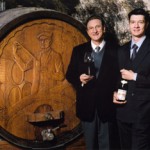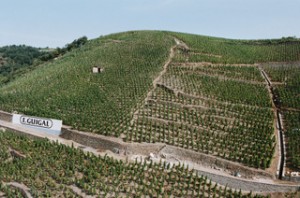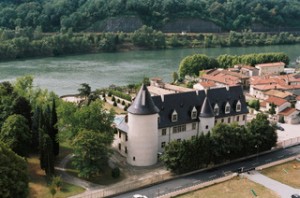E. Guigal
A shorter version of this article first appeared in Australia’s Winestate magazine in 2008. Updated August 2009.
The Guigal family is one of the iconic producers of the Rhône Valley in France., and the northern Rhône appellation of Côte Rôtie is at the very heart of the company. Syrah (shiraz) is grown here, and a little viognier. No other grapes are permitted to be grown.

Marcel and Philippe Guigal
Guigal was founded by Etienne Guigal, in 1946, in the town of Ampuis. It became one of the leading international lights of the Rhône under the auspices of Etienne’s son, Marcel who almost single-handedly led the revival of the small appellation, after he took over the business in 1961.
Third generation Philippe is now at the helm of a substantial business, having taken over twelve years ago, when he was just 22. And, with three degrees, (from the Universities of Dijon and Bordeaux, and an International MBA where he studied in 17 countries), as well as a life-time of wine experience, he is well placed to take the company to its next natural level.
Côte Rôtie
The appellation Côte Rôtie, which translates as ‘roasted slope’, extends to just over 200 hectares (ha), and includes some of the most inhospitable vineyard terrain, where some vineyards have a slope of 45° – impossible to work but for the most determined of manual labour. Machines are unheard of. It’s even too steep for animal labour. Many of Guigal’s vineyards on such slopes.

Côte Rôtie
The area oozes viticultural history from every leaf pore. Records show vines were cultivated here 2,400 years ago.
Côte Rôtie is a special spot where the river Rhône bends to expose vineyards to a perfect south-east aspect (considered ideal in European climes to capture the morning and day-time sun through the day). This aspect also protects the vines to some degree from the cold winds that buffet the northern Rhône.
Traditionally the appellation is split into the ‘blonde slopes’ – Côte Blonde – and the ‘brown slopes’ – Côte Brune – and a certain style of wine emanates from each patch of dirt, or terroir, as the French might say. Philippe explained: “Côte Blonde has schist soils of a calcareous nature, and mostly southern exposure. It expresses finesse [of syrah]. Côte Brune extends to the north, the soils have more clay and iron oxides, thus producing more powerful and structured wines“ with a deeper colour. Guigal’s ‘Brune et Blonde’ label blends wines from both these slopes.
Winemaking
Guigal’s philosophy on the use of oak might raise a few eyebrows in Australia. The top wines spend three and a half years in 100% new oak as part of their maturation. Philippe said: “my father and grandfather were fascinated by the history of winemaking. They read in 150 to 200 year old books that the first growths [in Côte Rôtie] were aged for 4 years in new pièces”. A pièce is a barrel of 228 litres, which is three litres bigger than the size of oak barrel commonly used – a barrique, at 225 litres.
“When my grandfather and father started to buy vineyards in the 1960s, they worked on these purist traditions, which was very controversial in the 60s. Most producers were using 40 to 50 year old chestnut barrels at that time.” Philippe stressed “you cannot leave every wine for so long in oak because you would get oak juice. You have to know the terroir and the vinification.”
Apart from the oak thing, Philippe often gets asked about the use of viognier with syrah, which has become enormously trendy over the past few years in Australia. Côte Rôtie is both the birthplace of syrah, and of syrah-with-a-bit-of-viognier, and it is to this French appellation that countries such as Australia, California and South Africa look for inspiration with the syrah grape variety. But Philippe has been unable to help new world producers, because, he said: “the vineyard is co-planted with viognier. It was done 70 years ago, and when a viognier vine dies, we replace it with a viogner. We try to keep the percentage of viognier consistent.”
Château d’Ampuis

Château d'Ampuis
The Château is the family home and business headquarters, having been bought in 1995, and painstakingly restored over the subsequent eleven years. The oldest parts of the Château are from the 11th and 12th centuries, with the Château itself dating from the 16th century. Coming full circle, the Château is where, in the 1930s, Etienne met Philippe’s grandmother, Marcelle, when she was working there as a housemaid. Now it is a national monument, said Philippe, “we do a lot of receptions there, all the growers [in the Côte Rôtie] can use the Château if they want”. Phillipe said that after their first growths of La Landonne, La Turque and La Mouline – top-top wines made in tiny quantities – the very best fruit goes into the Château label. See below for line up of Guigal’s Côte Rôtie wines.
But the Guigal business is not just Côte Rôtie, as Philippe explained. “We have three businesses. The estate, which is about 60 ha in northern Rhône, on steep vineyards only. We also purchase grapes from small growers in the northern Rhône, where we do all the work and the vinification. And we have a pure negociant business in the southern Rhône where we buy finished wines.” Philippe said their negociant business, though they make their purchasing decisions on blind tastings every year, have found they are often buying wines from the same producers.
The full list of appellations worked by the Guigal family is:
- Northern Rhône: Côte Rôtie, Hermitage, St. Joseph, Crozes Hermitage (red and white), Condrieu.
- Southern Rhône: Châteauneuf-du-Pape, Côtes du Rhône (red, white, rosé), Gigondas, Tavel
Celebrations
The family were delighted to have won the Winestate award in 2008. Philippe was completely charming and humble when he said: “My father and I are unusual French people. We taste a lot of [syrah and viognier] wines, from Australia, California and around the world. There are outstanding terroirs everywhere, different terroirs.
“I have lot of respect for the traditions in Australia. We share this idea of tasting wines throughout the world, and tasting wines next to each other, where wines are not competitors, they’re just different.”
There was another celebration in the Guigal family as 34-year-old Philippe got married in July 2008. He married the girl next door … to the family summer home in Corsica. Eve is already part of the business, working on the marketing and communications for the family, her specialty.
| Name of wine | La Mouline | La Turque | La Landonne | Château d’Ampuis | Brune et Blonde |
| Côte Rôtie vineyard area | Côte Blonde | Côte Brune | Côte Brune style, but Landonne identity | 6 vineyards: 3 blondes and 3 brunes | Brune and blonde |
| Size of vineyard |
1 ha |
<1 ha |
2.3 ha |
8 ha |
~90 ha |
| Syrah in blend (%) |
89 |
93 |
100 |
93 to 95 |
96 |
| Viognier in blend (%) |
11 |
7 |
0 |
5 to 7 |
4 |
| First vintage |
1966 |
1985 |
1978 |
1995 |
1942 |
| No. bottles produced |
5,000 |
4,800 |
12,000 |
25,000 |
250,000 |
| Average vineyard age in 2008 |
80 |
20 |
33 |
60 |
40 |
| No. months in oak |
42 – 100% new |
42 – 100% new |
42 – 100% new |
38 – 100% new |
36 – 40% new |
| Yield (hl/ha) |
37 |
37 |
37 |
37 |
37 |
| Soil | Gneiss with lightly coloured silica soil with limestone loess | Silica, limestone with schist, clay and iron oxide | Limestone clay, very rich in iron oxide and manganese | Mix of Blonde et Brune | Mix of Blonde et Brune |



